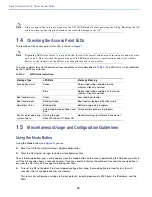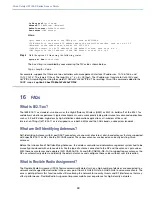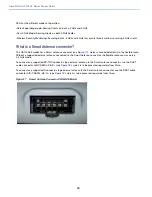
31
Cisco Catalyst 9130AX Series Access Points
To clear the AP internal storage, including all configuration files, keep the mode button pressed for more than 20
seconds, but less than 60 seconds.
Note
If the mode button is pressed for more than 30 seconds but less than 60 seconds, the FIPS mode flag is
also cleared during the full factory reset of the AP. The FIPS flag when set disables console access.
The AP status LED changes from Blue to Red, and all the files in the AP storage directory are cleared.
If you keep the mode button pressed for more than 60 seconds, the mode button is assumed faulty and no changes are
made.
Troubleshooting the Access Point to Cisco Controller Join Process
Note
As specified in the
Cisco W ireless Solutions Softw are Com patibility M atrix
, ensure that your controller is
running controller software release 8.9.111.0 or IO S-XE 16.12.1 or later to support C9130AXI or
8.10.105.0 or IO S-XE 16.12.2 or later to support C9130AXE.
Access points can fail to join a controller for many reasons: a RADIUS authorization is pending; self-signed certificates
are not enabled on the controller; the access point and the controller regulatory domains don’t match, and so on.
Controller software enables you to configure the access points to send all CAPWAP-related errors to a syslog server.
You do not need to enable any debug commands on the controller because all of the CAPWAP error messages can be
viewed from the syslog server itself.
The state of the access point is not maintained on the controller until it receives a CAPWAP join request from the access
point. Therefore, it can be difficult to determine why the CAPWAP discovery request from a certain access point was
rejected. In order to troubleshoot such joining problems without enabling CAPWAP debug commands on the controller,
the controller collects information for all access points that send a discovery message to it and maintains information for
any access points that have successfully joined it.
The controller collects all join-related information for each access point that sends a CAPWAP discovery request to the
controller. Collection begins with the first discovery message received from the access point and ends with the last
configuration payload sent from the controller to the access point.
When the controller is maintaining join-related information for the maximum number of access points, it does not collect
information for any more access points.
An access point sends all syslog messages to IP address 255.255.255.255 by default.
You can also configure a DHCP server to return a syslog server IP address to the access point using option 7 on the
server. The access point then starts sending all syslog messages to this IP address.
When the access point joins a controller for the first time, the controller sends the global syslog server IP address (the
default is 255.255.255.255) to the access point. After that, the access point sends all syslog messages to this IP address
until it is overridden by one of the following scenarios:
The access point is still connected to the same controller, and the global syslog server IP address configuration on
the controller has been changed using the
config ap syslog host global syslog_server_IP_address
command. In
this case, the controller sends the new global syslog server IP address to the access point.
The access point is still connected to the same controller, and a specific syslog server IP address has been
configured for the access point on the controller using the
config ap syslog host specific Cisco_AP
syslog_server_IP_address
command. In this case, the controller sends the new specific syslog server IP address
to the access point.
















































